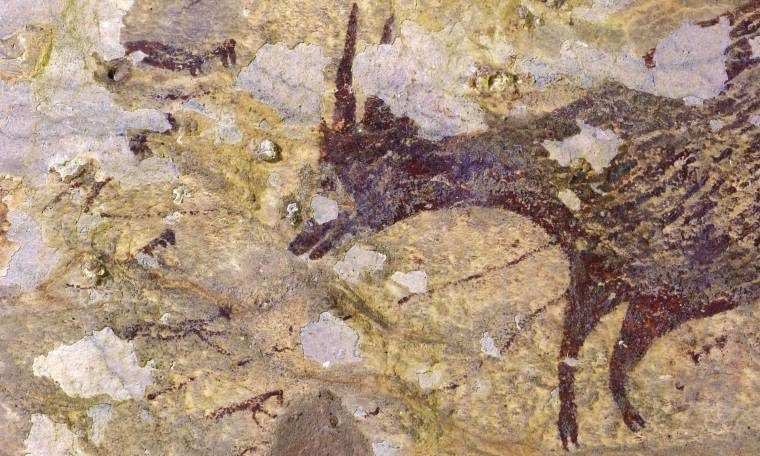
The artwork in Indonesia is nearly twice as old as any previous hunting scene and provides unprecedented insights into the earliest storytelling and the emergence of modern human cognition.
Previously, images of this level of sophistication dated to about 20,000 years ago, with the oldest cave paintings believed to be more basic creations such as handprints.

The painting, discovered in 2017, is one of hundreds in South Sulawesi, including a red hand stencil, which was dated to at least 40,000 years ago. But the latest finding is exceptional as it is more than twice as old as any previously known narrative scenes and hints at ancient myths and an early capacity for imagination.
"It suggested to us that this extraordinary scene suggests a story or some kind of myth," said Brumm.
The 4.5-metre-wide panel shows six fleeing mammals - two Sulawesi warty pigs and four dwarf buffaloes, known as anoas, small but fierce animals that still inhabit the island's dwindling forests. The animals are being pursued by human-like figures with some animal features (academics call these therianthropes), who seem to be wielding long swords or ropes. Their bodies are human-shaped but one appears to have the head of a bird and another has a tail.
Human-animal hybrids occur in the folklore of almost every modern society and are frequently cast as gods, spirits or ancestral beings in religions across the world.
"The most fascinating aspect is it has all the key elements of modern human cognition," said Prof Maxime Aubert, an archaeologist at Australia's Griffith University. "Hand stencils, a narrative scene, human-like figures that were conceived of something that doesn't really exist in the real world. Everything is there by 44,000 years ago."
The cave is in a well-explored system, which researchers had visited frequently over the past decade. The discovery was made after an expedition member noticed what appeared to be an entrance to a high level chamber above and climbed up a fig tree to investigate. "And then, bang, there's this incredible new rock art site in there that's essentially like nothing we've ever seen before in this entire region," said Brumm.
Rock art is difficult to date, and the scientists relied on analysing mineral growths known as cave popcorn, that had formed over the painting. Measuring the radioactive decay of uranium and other elements in the deposits gave dates ranging from 35,100 to 43,900 years as a minimum age for the Sulawesi discovery. The findings are described in the journal Nature.
"It's just amazing and to me it just shows how much more rock art that is out there waiting to be discovered that completely changes our understanding of the human story," said Brumm.
Before this latest discovery, the oldest undisputed examples of figurative cave art date to about 35,000 years old. The oldest cave art on record is abstract forms attributed to Neanderthals, which have been dated to 64,000 years old. The art features lines, dots and animal-like shapes.




I am more inclined to accept such records as depictions not of a hunt but of Cosmic event - understood in terms of a hunt.
If the ancients were imaginative where is the ongoing cultural development?
WE are imaginative from a development of a dissociated consciousness.
We have almost NO sense of what 'Divinity' was as the reflecting experience of a consciousness not like ours at all.
Likewise we almost NO sense of the function of megalithic and early civilised artefacts.
We see though our experience of our being.
We fail to see as a result of concretised experience set in place of being - as world set outside and apart.